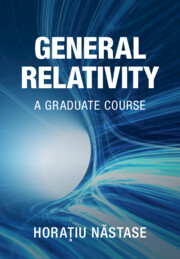Refine listing
Actions for selected content:
17002 results
Frontmatter
-
- Book:
- General Relativity
- Published online:
- 24 April 2025
- Print publication:
- 08 May 2025, pp i-iv
-
- Chapter
- Export citation
19 - Wald entropy and Sen’s entropy function formalism
-
- Book:
- General Relativity
- Published online:
- 24 April 2025
- Print publication:
- 08 May 2025, pp 199-208
-
- Chapter
- Export citation
32 - The Bianchi classification of Lie algebras, Riemannian manifolds, and cosmologies
-
- Book:
- General Relativity
- Published online:
- 24 April 2025
- Print publication:
- 08 May 2025, pp 354-361
-
- Chapter
- Export citation
Dedication
-
- Book:
- General Relativity
- Published online:
- 24 April 2025
- Print publication:
- 08 May 2025, pp v-vi
-
- Chapter
- Export citation
22 - Effective field theory from gravity and black holes
-
- Book:
- General Relativity
- Published online:
- 24 April 2025
- Print publication:
- 08 May 2025, pp 231-247
-
- Chapter
- Export citation
10 - The ADM parametrization and applications
-
- Book:
- General Relativity
- Published online:
- 24 April 2025
- Print publication:
- 08 May 2025, pp 105-115
-
- Chapter
- Export citation
9 - Gravity and geometry, Lovelock and Chern–Simons, topological terms, extensions, and anomalies
-
- Book:
- General Relativity
- Published online:
- 24 April 2025
- Print publication:
- 08 May 2025, pp 96-104
-
- Chapter
- Export citation
13 - Penrose diagrams and black holes: the Schwarzschild example
-
- Book:
- General Relativity
- Published online:
- 24 April 2025
- Print publication:
- 08 May 2025, pp 137-148
-
- Chapter
- Export citation
8 - Vielbein–spin connection formulation of general relativity: gravity vs. gauge theory, in four dimensions and three dimensions
-
- Book:
- General Relativity
- Published online:
- 24 April 2025
- Print publication:
- 08 May 2025, pp 86-95
-
- Chapter
- Export citation
29 - The (parametrized) post-Newtonian expansion and metric frames
-
- Book:
- General Relativity
- Published online:
- 24 April 2025
- Print publication:
- 08 May 2025, pp 323-335
-
- Chapter
- Export citation

General Relativity
- A Graduate Course
-
- Published online:
- 24 April 2025
- Print publication:
- 08 May 2025
Appendix B - Ganymede Parameters
-
- Book:
- Ganymede
- Published online:
- 03 February 2025
- Print publication:
- 20 February 2025, pp 336-349
-
- Chapter
- Export citation
Part IV - Astrobiology
-
- Book:
- Ganymede
- Published online:
- 03 February 2025
- Print publication:
- 20 February 2025, pp 317-318
-
- Chapter
- Export citation
10 - Ganymede’s Surface Composition
- from Part II - Geology, Surface, Interior
-
- Book:
- Ganymede
- Published online:
- 03 February 2025
- Print publication:
- 20 February 2025, pp 147-164
-
- Chapter
- Export citation
19 - Electrodynamic Coupling between Ganymede and the Jovian Ionosphere
- from Part III - Atmosphere, Ionosphere, Magnetosphere
-
- Book:
- Ganymede
- Published online:
- 03 February 2025
- Print publication:
- 20 February 2025, pp 302-316
-
- Chapter
- Export citation
11 - Physical Chemistry and Thermal Properties of Ices at Ganymede
- from Part II - Geology, Surface, Interior
-
- Book:
- Ganymede
- Published online:
- 03 February 2025
- Print publication:
- 20 February 2025, pp 165-180
-
- Chapter
- Export citation
15 - Interactions between the Space Environment and Ganymede’s Surface
- from Part III - Atmosphere, Ionosphere, Magnetosphere
-
- Book:
- Ganymede
- Published online:
- 03 February 2025
- Print publication:
- 20 February 2025, pp 237-251
-
- Chapter
- Export citation
Part I - History, Origin, Dynamics
-
- Book:
- Ganymede
- Published online:
- 03 February 2025
- Print publication:
- 20 February 2025, pp 1-2
-
- Chapter
- Export citation
13 - The Origin of Ganymede’s Internal Magnetic Field
- from Part II - Geology, Surface, Interior
-
- Book:
- Ganymede
- Published online:
- 03 February 2025
- Print publication:
- 20 February 2025, pp 197-212
-
- Chapter
- Export citation
4 - Tidal Deformation and Tidal Evolution of Ganymede
- from Part I - History, Origin, Dynamics
-
- Book:
- Ganymede
- Published online:
- 03 February 2025
- Print publication:
- 20 February 2025, pp 46-58
-
- Chapter
- Export citation
